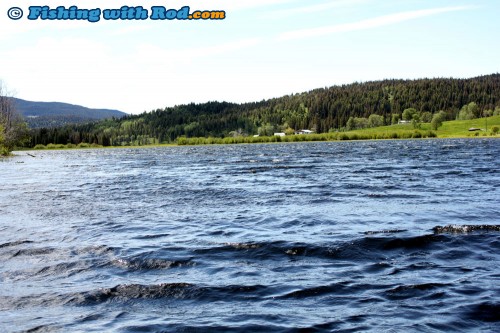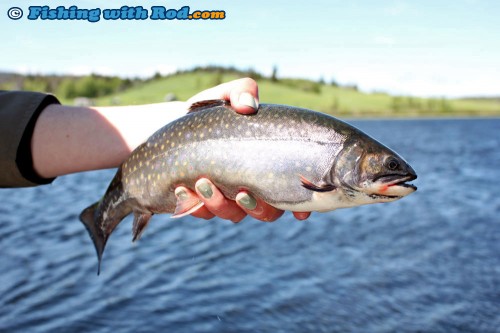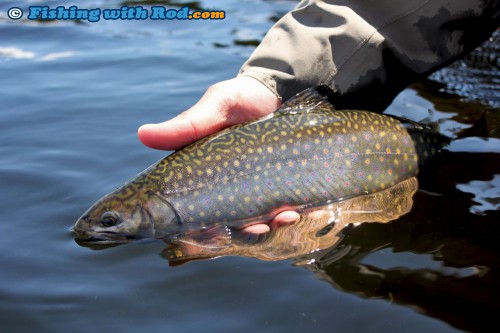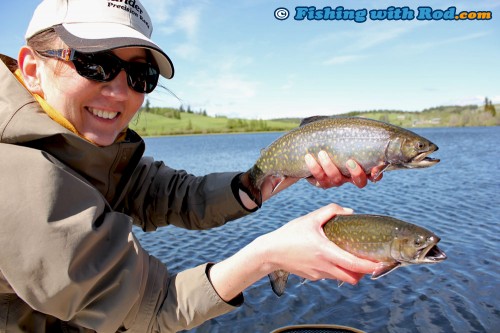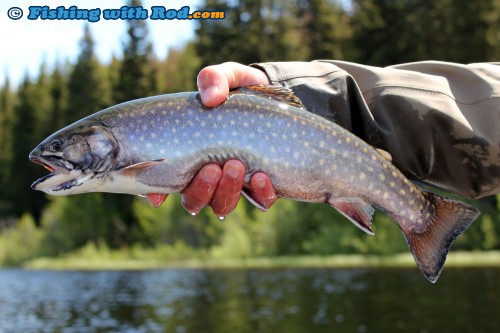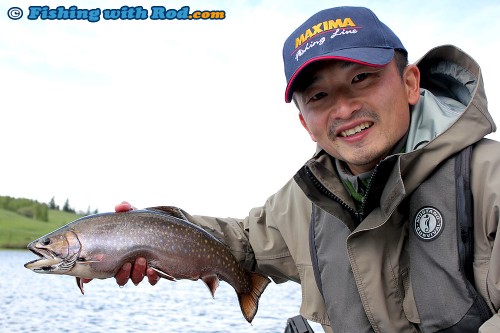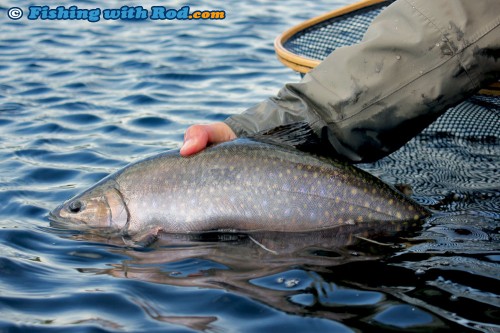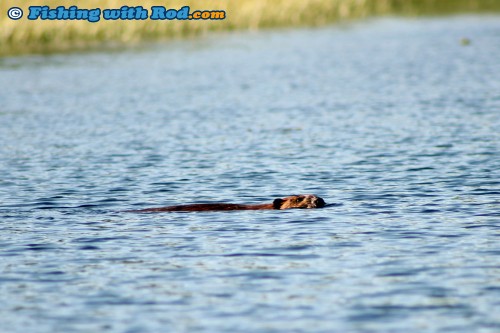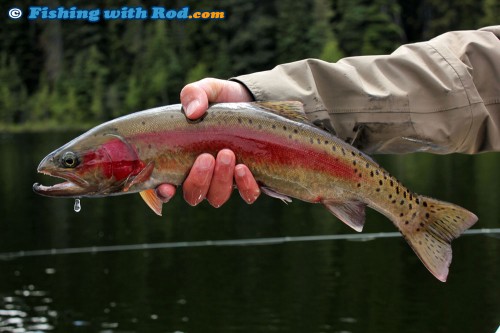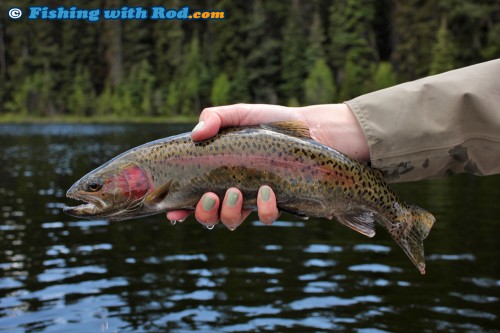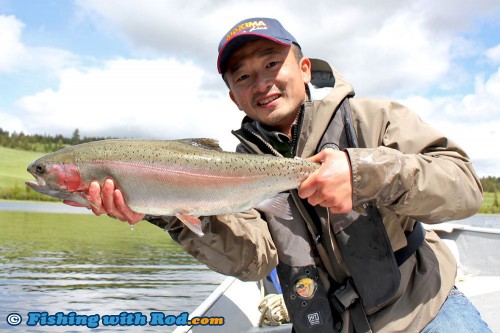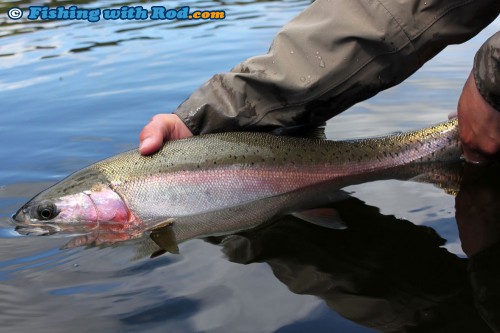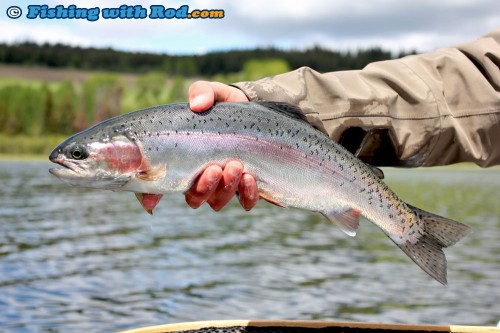Brookies and bows
Published on July 3rd, 2011 by admin
Unless you have been living in a cave in the last few months, you must have noticed how inconsistent the weather has been this spring in British Columbia. From one snowy day to another rainy day, the sun hardly made its appearance. To anglers who are eager to hit the lakes in Interior BC every spring, this has been a rather frustrating year. Like many others, we had been anxious to make a trip to the Thompson-Nicola region since May, but the last-minute changing weather held us back. After changing our minds several times, we finally decided to give it a go last week.
Because we’ve only been doing stillwater fly fishing since 2007, it is still relatively new to us so I’m always a bit hesitant when choosing the lakes. I decided that we should play it safe by visiting a couple of lakes where I had success in the past – One that has many brook trout in the same age class, while the other that has rainbow trout in a variety of sizes.
After driving through the misty coastal mountain range, we arrived in Merritt and the sun greeted us. The blue sky was a consolation, because the area was pounded by strong gusts. Wind is always an issue when lake fishing in this area, one simply has to deal with it by either braving the open water or finding sheltered spots.
We arrived at our first chosen lake around Noon. Only one other person was at the lake but he was not fishing. It wasn’t surprising, the wind was keeping him out of the water. We took our time setting up the boat, hoping that it would calm down eventually. That hope diminished as the gusts turned into hurricane strength. Reluctantly, we headed out to test the waters, only to be blown around as if we were in the middle of the Pacific Ocean. After struggling for awhile, we finally found a slightly more sheltered spot at one corner of the lake. It was time to hook a fish!
We started out by fishing with chironomid in size 14. The chosen colour was silver with red ribs. Because we were fishing in fairly shallow waters, it made adjusting the indicator depth rather easy. I tossed mine out and let it settled while rigging up Nina’s rod. Within minutes, my indicator began bobbing up and down occasionally. Thinking that it was wind, I neglected it so I could finish her setup quickly. They were in fact bites. Unlike rainbow trout, brook trout’s takes tend to be pretty light and your strikes have to be pretty precise to hook them.
Once both our indicators were floating nicely, we were excited to see who would get the first fish. Within a minute, Nina’s indicator dipped and she set the hook precisely. The rod was pulled downward as the fish headed for the deep water. Brook trout rarely jump, they often dive and hold their position in the deep. It took a couple of minutes for the fish to surface. The first brook trout, just over 1lb, was in the net.
After a few photos, we sent the fish back to the lake. Nina was into another fish not long after she sent the fly back out. By now I was getting slightly frustrated. My hookup rate was rather sad. After her third fish into the net, I was finally able to connect with one. The pulls definitely felt good after some struggles.
We ended our first day with around a dozen hookups. Although none of our catches were exceptionally big, it worked out better than we expected considering how rough the lake was.
We decided to give the same lake another try on our second day. The late morning start was even better than the previous day. Perhaps the chironomid hatch was stronger, we could not keep fish away from our flies!
Among the average-sized fish, we finally were able to find some bigger fish, in the 2 to 3lb range. These bigger fish were not much longer, but they were certainly much fatter. My biggest disappointment was the biggest fish that snapped the line before we had a chance to see it. It is always a good idea to check the leader after landing multiple fish.
We decided to end our second day earlier as we were satisfied with the number of fish that we connected with. The day was mostly sunny and the wind was lighter, beavers and loons swam around us without much disturbance. Having the entire lake to ourselves, this was definitely what quality lake fishing is all about in BC.
On our final day, we decided to visit another lake that has rainbow trout in it. Originally, I wanted to fish for more brook trout but Nina insisted that she was bored with them and wanted to catch some big rainbow trout.
We headed to a lake that we fished last year. Our previous visits were never so lucky. Each trip usually ended with only one or two catches. Because it was Saturday, there was a lot more traffic on the lake. Including us, there were 14 boats hoping to catch some nice rainbows. The morning was mild, but rather cloudy. We started out by anchoring near others, but the lake was void of action for two hours. Nearby chironomid fishers were doing just as bad, except a couple of fish that were hooked by one angler. Most boats were slowly trolling, but none were able to find a fish.
With such discouraging result, Nina wanted to move to a new spot. We decided to take the boat away from the traffic and anchored not far from where we launched the boat. Once I dropped the anchors, I noticed a rather heavy hatch happening around us. The water was 20ft deep in front of us, so I had one rod’s indicator depth set at 19ft, while the other one set at 16ft.
The move definitely paid off, because Nina’s indicator started dipping not long after we settled down. I screamed, but watched Nina’s rod sitting idly on the boat. Her mind had already wandered away after not seeing a bite for so long. By the time she yanked it, the fish was long gone. Not long after, her indicator took another dive! Again, the driver was not at the wheel. After missing two chances, Nina was ready to get the job done. The next bite again came in no time. With the rod in her hand this time, she was into the first fish of the day. It went for a couple of dives before showing some flashes below our boat. Unaware that her indicator had not released itself from the line, Nina frantically stripped in her line. Eventually the indicator reached the rod tip and she could not bring in more line. With just under 20ft of line between the rod and the fish, it was not a surprise that it came off the hook after some struggles.
I was both frustrated with seeing so many losses and encouraged by the number of bites she had. With an adjustment to my indicator depth and a switch in fly pattern, I was also into a fish quickly. The fish surfaced without much of a fight, because it was a spawner. Rainbow trout spawn in the spring, so it is not uncommon to see coloured fish occasionally.
Nina’s first fish came after I released mine, but it was also a coloured fish. Were we simply targeting a school of coloured fish? That question was answered by our next fish.
The bites were in fact rather light. The indicators dipped slightly each time. Adding a twitch to the fly after each dip, usually resulted in a good pull-down. My next pull-down sent the reel screaming. Before I had a chance to imagine how big the fish was, it leaped straight out of the water on the other side of Nina’s line. She quickly retrieved her fly, narrowly missing my line. By this point, the fish had already moved to the other side of the boat. It was a big fish, much bigger than what I expected to catch at this lake. This fish created some chaos on the boat as it circled around us. I nervously put pressure on the line, hoping the 4lb test tippet would not snap like the day before. After several netting attempts as it was too big for our net, I finally brought in my biggest rainbow trout to date. We didn’t bother measuring the fish, just admired its size. All I know is that our landing net was way too small for it.
After the beast was released, I was able to connect with a couple of more fish. Nina on the other hand, was not so lucky. With only misses and a few losses, she had to settle with one coloured fish before we headed home at 3:00pm. Nevertheless, both of us agreed that it ended well, considering other boats were not as lucky.
Even though the weather was not as nice as we had hoped for, the fishing definitely made up for it. This was definitely one of the better lake trips that we’ve experienced in the Thompson-Nicola region. For now, our boat will be packed away as we start getting ready for some river fly fishing.

